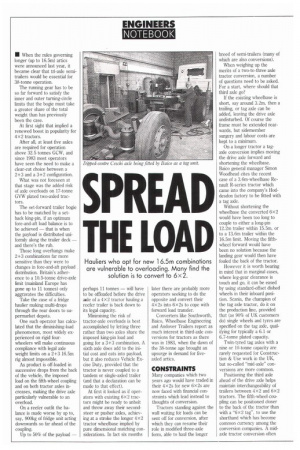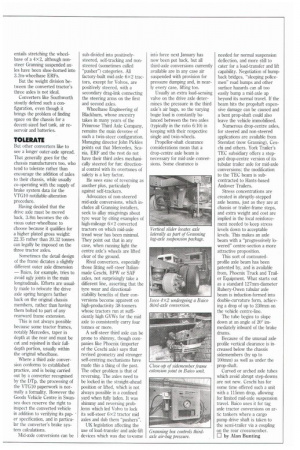THE LOA
Page 42

Page 43

If you've noticed an error in this article please click here to report it so we can fix it.
Hauliers who opt for new 16.5m combinations are vulnerable to overloading. Many find the solution is to convert to 6x2.
• When the rules governing longer (up to 16.5m) artics were announced last year, it became clear that tri-axle semitrailers would be essential for 38-tonne operation.
The running gear has to be so far forward to satisfy the inner and outer turning-circle limits that the bogie must take a greater share of the total weight than has previously been the case.
At first sight that implied a renewed boost in popularity for 4 x 2 tractors.
After all, at least five axles are required for operation above 32.5 tonnes GCW, and since 1983 most operators have seen the need to make a clear-cut choice between a 2+3 and a 3+2 configuration.
What was not foreseen at that stage was the added risk of axle overloads on 17-tonne GVW plated two-axled tractors.
The set-forward trailer bogie has to be matched by a setback king-pin, if an optimum fore-and-aft load balance is to be achieved — that is when the payload is distributed uniformly along the trailer deck and there's the rub.
Those long overhangs make 2+3 combinations far more sensitive than they were to changes in fore-and-aft payload distribution. Britain's adherence to a 10.5-tonne drive-axle limit (mainland Europe has gone up to 11 tonnes) only aggravates the difficulties.
Take the case of a fridge haulier making multi-drops through the rear doors to supermarket depots.
One such operator has calculated that the diminishing-load phenomenon, most widely experienced on rigid fourwheelers will make continuous compliance with legal axle weight limits on a 2+3 16.5m rig almost impossible.
As product is off-loaded in successive drops from the back of the vehicle, the imposed load on the fifth-wheel coupling and on both tractor axles increases, making the drive axle particularly vulnerable to an overload.
On a reefer outfit the balance is made worse by up to, say, 900kg of fridge unit acting downwards so far ahead of the coupling.
Up to 50% of the payload — perhaps 11 tonnes — will have to be offloaded before the drive aide of a 4x2 tractor hauling a reefer trailer is back down to its legal capacity.
Minimising the risk of tractor-axle overloads is best accomplished by letting three rather than two axles share the Unposed king-pin load and going for a 3+3 combination. A sixth axle does add to the initial cost and eats into payload, but it also reduces Vehicle Excise Duty, provided that the tractor is never coupled to a tandem or single-axled trailer (and that a declaration can be made to that effect).
At first it looked as if operators with existing 6x2 tractors might be ready to unbolt and throw away their secondsteer or pusher axles, achieving at a stroke the longer 4x2 tractor wheelbase implied by pure dimensional matching considerations. In fact six months later there are probably more operators seeking to do the opposite and convert their 4x 2s into 6 x2s to cope with forward load transfer.
Converters like Southworth, Baico, Wheelbase Engineering and Andover Trailers report as much interest in third-axle conversions for tractors as there was in 1983, when the dawn of the 38-tonne age brought an upsurge in demand for fiveaxled artics.
CONSTRAINTS
Many companies which two years ago would have traded in their 4x2s for new 6x2s are now faced with financial constraints which lead instead to thoughts of conversion.
Tractors standing against the wall waiting for loads can be sent off for conversion, after which they can resume their role in modified three-axle form, able to haul the longer breed of semi-trailers (many of which are also conversions).
When weighing up the merits of a two-to-three axle tractor conversion, a number of questions need to be asked. For a start, where should that third axle go?
If the existing wheelbase is short, say around 3.2m, then a trailing, or tag axle can be added, leaving the drive axle undisturbed. Of course the frame must be extended rearwards, but sidemember surgery and labour costs are kept to a minimum.
On a longer tractor a tagaxle conversion implies moving the drive axle forward and shortening the wheelbase. Baico general manager Simon Woodhead cites the recent case of a 3.6m-wheelbase Renault R-series tractor which came into the company's Hoddesdon factory to be fitted with a tag axle.
Without shortening the wheelbase the converted 6x 2 would have been too long to couple to either a long-pin 12.2m trailer within 15.5m, or to a 13.6m trailer within the 16.5m limit. Moving the fifthwheel forward would have been no solution because the landing gear would then have fouled the back of the tractor.
However it is worth bearing in mind that in marginal cases, where leg-gear clearance is touch and go, it can be eased by using standard-offset dished wheels in their inboard position. Scania, the champion of the tag axle tractor, do it on the production line, provided that (as 90% of UK customers do) single wheels and tyres are specified on the tag axle, qualifying for typically a 6.1 or 6.7-tonne plated capacity.
Twin-tyred tag axles with a nine or 10-tonne capacity are rarely requested for Construction & Use work in the UK, but so-called "mid-axle" conversions are more common.
Positioning the third axle ahead of the drive axle helps maintain interchangeability of trailers between 4x2 and 6X2 tractors. The fah-wheel coupling can be positioned closer to the back of the tractor than with a "6X2 tag", to use the shorthand which has become common currency among the conversion companies. A midaxle tractor conversion often entails stretching the wheelbase of a 4 x 2, although nonsteer Granning suspended axles have been shoe-horned into 3.2m-wheelbase ERFs.
But the weight division between the converted tractor's three axles is not ideal.
Converters like Southworth stoutly defend such a configuration, even though it brings the problem of finding space on the chassis for a decent-sized fuel tank, air reservoir and batteries.
TOLERATE
But other converters like to see a longer outer-axle spread.. That generally goes for the chassis manufacturers too, who tend to tolerate rather than encourage the addition of axles to their chassis, while usually co-operating with the supply of brake system data for the VTG10 notifiable-alteration procedure.
Having decided that the drive axle must be moved back, 3.8m becomes the obvious outer-wheelbase to choose because it qualifies for a higher plated gross weight: 22.35 rather than 20.32 tonnes can legally be imposed on the three tractor axles.
Sometimes the detail design of the frame dictates a slightly different outer axle dimension — Baico, for example, tries to avoid ugly joints in the main longitudinals. Efforts are usually made to relocate the drive axle spring hangers further back on the original chassis members, rather than having them bolted to part of any rearward frame extension.
This is not always possible because some tractor frames, notably Mercedes, taper in depth at the rear and must be cut and rejoined in their fulldepth portion, usually within the original wheelbase.
Where a third axle conversion conforms to established practice, and is being carried out by a converter recognised by the DTp, the processing of the VTG10 paperwork is normally a formality. However the Goods Vehicle Centre in Swansea does reserve the right to inspect the converted vehicle in addition to verifying its paper specification, and in particular the converter's brake system calculations.
Mid-axle conversions can be sub-divided into positivelysteered, self-tracking and nonsteered (sometimes called "pusher") categories. All factory-built mid-axle 6x2 tractors, except for Volvos, are positively steered, with a secondary drag-link connecting the steering arms on the first and second axles.
Wheelbase Engineering of Blackburn, whose ancestry takes in many years of the Primrose Third Axle Company, remains the main devotee of such a twin-steer configuration. Managing director John Pickles points out that Mercedes, Scania, ERF and the rest do not have their third axles mechanically steered for fun: directional control with its overtones of safety is a key factor.
He sees ease of reversing as another plus, particularly against self-trackers.
Advocates of non-steered mid-axle conversions, which includes all Granting installers, seek to allay misgivings about tyre wear by citing examples of high-mileage 6 x 2 converted tractors on which mid-axle tread wear has been minimal. They point out that in any case, when running light the centre axle's wheels are lifted clear of the ground.
Rival converters, especially those fitting self-steer Italianmade Ceschi, BPW or SAF axles, not surprisingly take a different line, asserting that the tyre wear and directionalstability benefits of their conversions become apparent on high-productivity 38-tonners whose tractors run at sufficiently high GVW's for the mid axle to consistently carry four tonnes or more.
A self-steer third axle can be prone to shimmy, though companies like Phoenix (importer of the Ceschi axle) says that revised geometry and stronger self-centring mechanisms have made this a thing of the past. The other problem is that of reversing. The axles need to be locked in the straight-ahead position or lifted, which is not always possible in a confined yard when fully laden. It was shimmy and reversing probterns which led Volvo to lock its self-steer 6 x 2 tractor mid axles and dub them "pushers".
UK legislation affecting the use of load-transfer and axle-lift devices which was due to-come intO force next January has now been put back, but all third-axle conversions currently available are in any case air suspended with provision for pressure dumping and, in nearly every case, lifting too.
Usually an extra load-sensing valve on the drive axle determines the pressure in the third axle's air bags, so the varying bogie load is constantly balanced between the two axles (typically in the ratio 6:10) in keeping with their respective single and twin-wheels.
Propellor-shaft clearance considerations mean that a drop-centre axle beam is necessary for mid-axle conversions. Some clearance is needed for normal suspension deflection, and more still to cater for a load-transfer and lift capability. Negotiation of humpback bridges, "sleeping policemen" road humps and other surface hazards can all too easily bump a mid-axle up beyond its normal travel. If the beam hits the propshaft expensive damage can be caused and a bent prop-shaft could also leave the vehicle immobilised.
Numerous drop-centre axles, for steered and non-steered applications are available from Stemfast (now Granting), Ceschi and others. York Trailer's TEC subsidiary offers a stepped drop-centre version of its tubular trailer axle for mid-axle conversions; the modification to the TEC beam is subcontracted to Hants-based Andover Trailers.
Stress concentrations are created in abruptly-stepped axle beams, just as they are at chassis or trailer-frame steps, and extra weight and cost are implied in the local reinforcement needed to keep stress levels down to acceptable levels. This makes an axle beam with a "progressively lowered" centre-section a more attractive proposition.
This sort of contouredprofile axle beam has been patented by, and is available from, Phoenix Truck and Trailer Equipment. What starts out as a standard 127mm-diameter Rubery-Owen tubular axle beam is induction-formed into double-curvature form, achieving a drop of up to 230mm on the vehicle centre-line.
The tube begins to slope down at an angle of 20° immediately inboard of the brake drums.
Because of the unusual axle profile vertical clearance is increased below the chassis sidemembers (by up to 100mtn) as well as under the prop-shaft.
Curved or arched axle tubes which avoid abrupt step-downs are not new. Ceschi has for some time offered such a unit with a 115mm drop, allowing for limited mid-axle suspension travel. Baico uses it for tag axle tractor conversions on artic tankers where a cargo pump drive shaft is taken to the semi-trailer via a coupling on the rear crossmember. O by Alan Bunting
























































































































